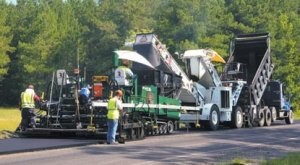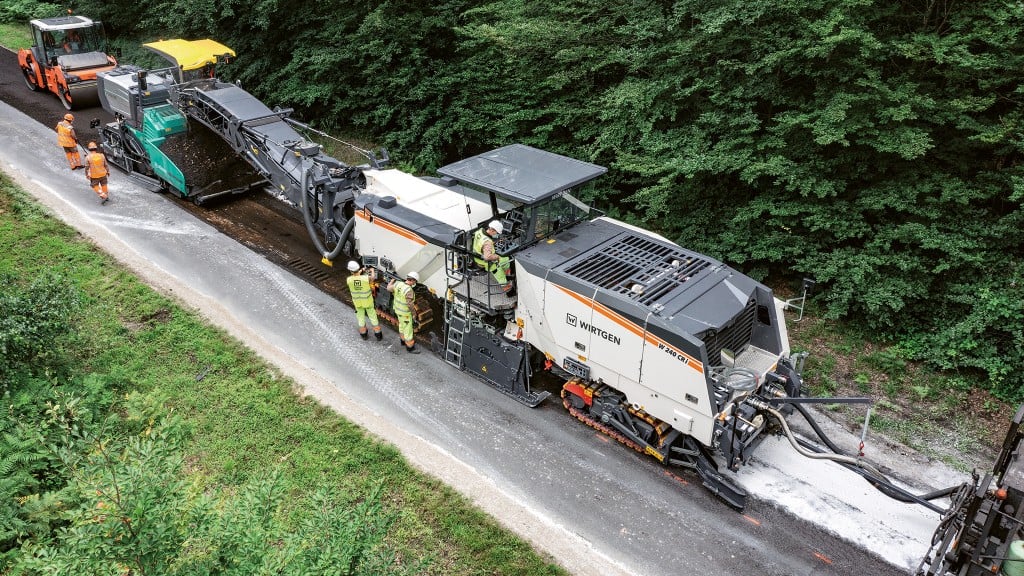
by Daniel C. Brown
Warm mix asphalt (WMA) technologies bring certain well-known benefits to contractors using them, such as less smoke and odour and a reduction in fuel usage. It is produced at temperatures ranging from 30 to 70 degrees less than conventional hot mix, so less heat is needed at the burner. Other benefits of WMA, however, are not so well known: • it is easier to compact and achieve specified density; • it is more workable, so it allows the paving season to be extended into cooler weather; and • asphalt producers are regularly increasing the amounts of reclaimed asphalt pavement that they run with warm mix, compared to hot mix asphalt. David Madden, vice president of Madden Contracting, thinks warm mix is absolutely fine. “The largest advantage to the contractor is that you get virtually a 100 percent guarantee that you’ll get the required density on the roadway. Plus it slides out of the truck easier, and it goes through the paver and Shuttle Buggy easier, so that’s a savings in maintenance on the equipment. And the carbon footprint is lessened with warm mix. You use less fuel, there are fewer emissions, and no blue smoke.” Madden said he has had no problems at all with WMA. And he reports a 14 to 16 percent reduction in fuel usage. “Warm mix is just hot mix minus the fumes and a little bit of heat.” Malcolm Swanson, vice president of engineering at Astec Inc. agrees with Madden. “I’m seeing that density is more easily achieved with warm mix. In some cases we’ve seen a contractor take a roller off the job because it wasn’t needed.
“And we’ve got a number of customers making hot mix with the foam attachment because they can achieve density more easily with the hot mix made that way. In some cases they’re producing mix at 300 degrees (149 degrees C) or higher with the foam attachment.” Swanson explained that “The whole purpose of producing warm mix is simply to produce hot-mix-like properties at a lower temperature. You can’t work hot mix at 250 degrees (121 degrees C), but with warm mix technologies, it will work at 250 degrees. If you apply a warm mix technology and happen to go above a temperature limit, why would that be bad? As long as you don’t overheat the mix, it will not be damaged in any way and you get the workability benefits – the lower compaction effort, even at a higher temperature. And if the mix cools down, it will still be workable at 250 degrees or so.”
Quality of WMA
A few lab tests on WMA have shown low tensile strength ratios (TSRs), which means that a WMA sample conditioned by hot and cold water has lower than normal tensile strength compared to an unconditioned sample. Astec’s Swanson said that the light ends of the liquid asphalt are retained in the asphalt mixture because of the lower mix temperature and he expects that these exit the mix in the months following paving. This would mean that WMA pavements end up with the same strength as hot mix after a few months of aging.
Increased RAP content
Astec’s Swanson says higher RAP contents are possible with warm mix because one of the limiting factors on RAP with hot mix is the baghouse temperature. (A baghouse cleans the dryer drum’s exhaust gases.) To illustrate, Swanson gave the following hypothetical example. If you have a hot mix asphalt running 30 percent RAP and your baghouse temperature is 300 degrees F – a common operating temperature – then you can run warm mix with 30 percent RAP and the baghouse temperature will drop to, say, 250 degrees F. But you can run the baghouse at 300 degrees F, or even a bit hotter. So you can increase your RAP percentage to, say, 50 percent, and the baghouse temperature will climb back to 300 degrees F.
Solving a transfer problem
One contractor recently reported difficulty in unloading WMA from the trucks into a Roadtec MTV-1000D transfer vehicle. “As the trucks were dumping into the transfer vehicle, the mix would bridge across the hopper on the transfer vehicle,” said Mike Varner, director of thermal systems and research, Astec Inc. “They had to jostle the hopper on the transfer vehicle.” Transit time for the mix, from plant to paving site, was about 50 minutes to an hour at the most. Three factors affected the time it took to dump that warm mix, Varner said. One was the mix temperature. The solution to that was to produce the mix at 280 to 285 degrees F (138 to 141 degrees C) at the plant; that way it held up to about 270 degrees F on the job. “We noticed that everything was fine when the mix stayed above 270 degrees (132 degrees C) on the job,” said Varner. The second factor was the project’s mix design. It was a very dense mixture, with a high sand content. As a result, it compacted very easily, and tended to bridge up in the truck and transfer vehicle hopper. “The cohesiveness of the mix was part of the issue,” said Varner. But nothing could be done to change that. The third factor was the speed with which the driver raised the truck bed. If he raised it high quickly, a large chunk of mix would slough off. “With this specific mix, at this specific temperature, it appeared to take more time to move through the hopper,” Varner said. “The driver should have tried to feed it more gradually. But that’s easy to say and difficult to do.
Fuel savings
The fuel savings produced by warm mix depends entirely on the difference in hot mix temperature and warm mix, Swanson said. Astec conservatively estimates most fuel savings at 14 to 16 percent. “I have seen 26 percent savings on jobs in the field,” he said. “But that was comparing hot mix made at 330 degrees (166 degrees C) to warm mix made at about 270 degrees (132 degrees C).”
Boom in warm mix systems
The Double Barrel Green system is an option that can be included with a new Astec Double Barrel drum mixer/dryer or added as a retrofit. Astec Industries reports that it has sold 185 of these warm mix systems.
The system – as described in the National Asphalt Pavement Association’s publication, Warm-Mix Asphalt: Best Practices – uses a multi-nozzle foaming device to inject a tiny amount of water into the binder to microscopically foam it. The device includes a manifold with a system of valves, mixing chambers and water nozzles. Each nozzle can be computer controlled, so that the amount of water can be regulated based on the production rate. Typically one pound of water is added per ton of mix. A small percentage of this water is encapsulated in the binder as steam, which increases the volume of the material.
The resulting production temperatures are typically 250 to 275 degrees F (132 to 135 degrees C), with compaction temperatures as low as 220 degrees F (104 degrees C). To summarize, key benefits of the warm mix system are improved workability as the foamed liquid asphalt coating has a lower viscosity; no smoke and no smell as the light oils in liquid asphalt never reach the boiling point, eliminating the smoke (vapour) and corresponding smell; the ability to run high percentages of recycle mix with a standard grade of asphalt; longer pavement life due to less oxidation of mix and more uniformity of compaction; 14 percent less fuel used in the virgin aggregate drying process; and 14 percent increase in production.



